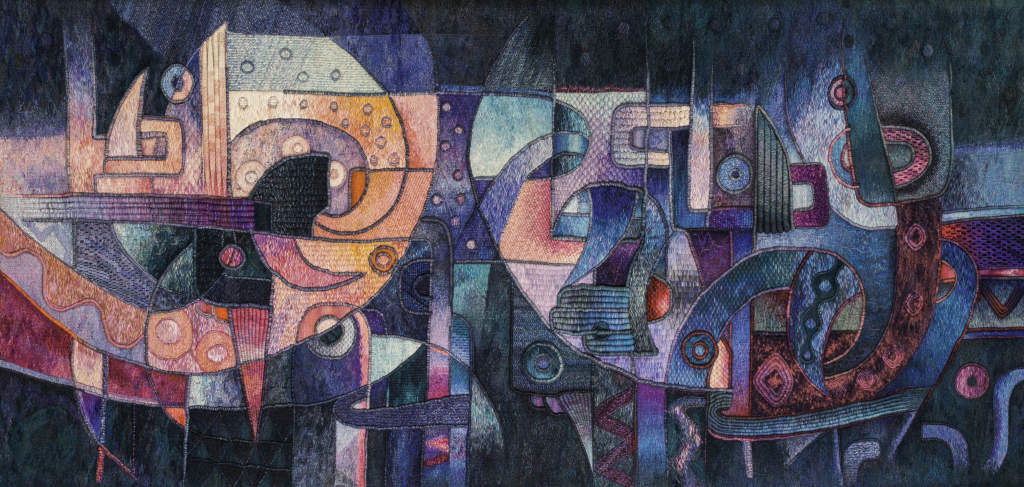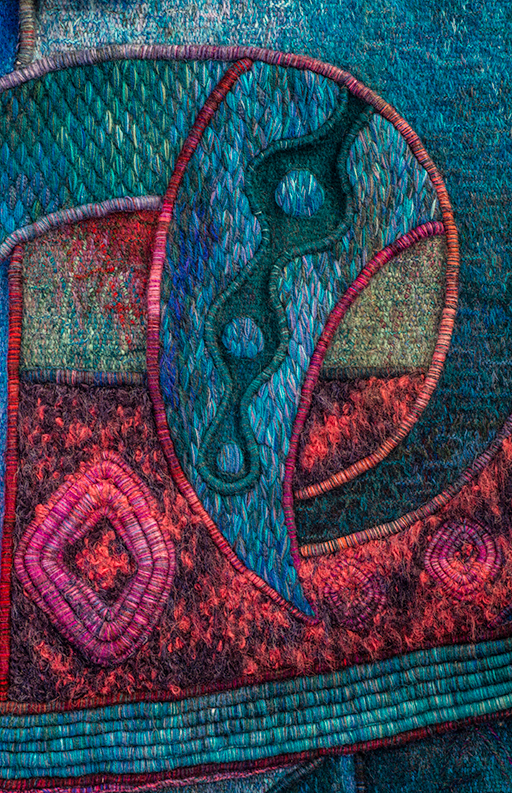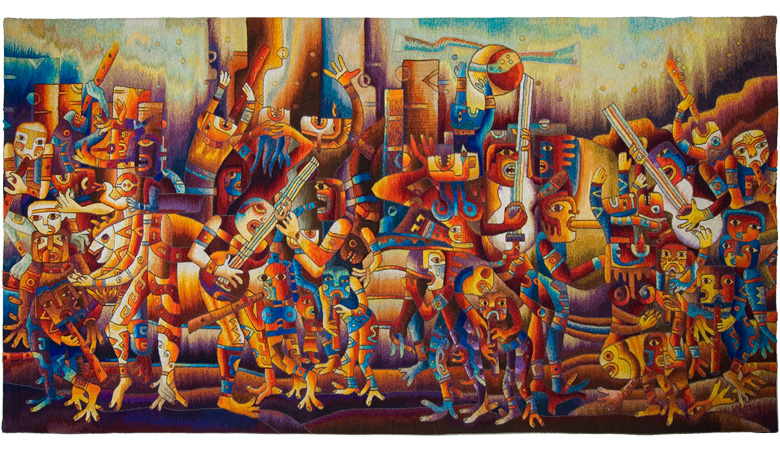A Life of Colours and Yarns: Peruvian Tapestry Weaver Maximo Laura
by Beatrijx Sterk for Textile Forum Magazine
Artistic Motivation
Maximo Laura’s intention is to express his view of the universe and to pass on his ancestors’ “energy” — not through repetition, but through adaptation to contemporary experience. In his view, “contemporary” means bearing witness to our day and age as a modern-day person.
Maximo realises that museum people are only interested in ancient Peruvian weaving, but he does not intend to enter into competition with the old ones. Nevertheless, elements of their culture are an important basis for his work. He has dedicated his whole life to weaving. At the age of seven, he began weaving in his father’s workshop and has always used his craft to make a living, even during his student days when he lived in Lima to study Spanish literature. In the city, he encountered the work of Argentinian weaving artist Helvecia Kela Cremaschi, who was living in the Peruvian capital at the time. It was she who showed him the expressive potential of weaving. Since then, he has devoted himself to weaving as his form of expression. In our conversations he mentioned the names of painters important to him, Fernando De Szyszlo and Gerardo Chaves in Peru, Roberto Matta in Chile, Rufino Tamayo in Mexico and Alfredo Lam in Cuba. European painters are Paul Klee, Joan Miró and Pablo Picasso. To my surprise, he enthusiastically sang the praises of Jean Lurcat, calling him a master with new visions and a great gift to humankind.
Why textiles? — Painting is not his medium, textiles are more organic, pleasant and comfortable…


In western art, certain rules apply. However, Andean cultures have practised a different kind of art for thousands of years — one that conveys spiritual messages by means of colours and symbols. It is about harmony and balance, about the meaning of things rather than simple geometry. Maximo did not grow up with a western idea of art but, step by step, he has attempted to express his own cultural background.
Regrettably, the existing Andean culture is not perceived in the same light as, say, Chinese or Japanese culture. The cosmic view is still very current; there are rites, myths and visions. The spirit of Andean culture is still alive, although threatened with extinction. Above all, Maximo hopes to contribute to its survival: “Our modern society tells us that it’s everyone for themselves. However, we always talk about “us” although we know that two or three brains cannot be woven together.” As regards his choice of colour, he says: “In my work, I use colours as sources of energy and vitalisers — light is energy.”

Each piece begins as a painting. This is then enlarged by hand to produce a technical drawing detailing outlines and colour codes, the same method used in Aubusson gobelin weaving. Next Maximo prepares his materials — wool from Peru, not hand-spun, and aniline dyes from Switzerland. He only dyes single colour yarns, mixing them in the weft as they do in Aubusson, although the surface texture used there is not the one he prefers.
Making tapestries is project work and requires assistance. Weaving a large object by himself could take up to a year. “I am 51 now; weaving everything myself until the age of 75 would mean that I might only complete another 20 pieces. I would consider this a sad outlook.” Weaving without a cartoon? Yes, he does this occasionally to experiment when he has the time, which is rarely enough. His Lima weaving workshop employs 30 staff who have to provide for many family members.
To date some 2,000 designs have been created, some of them produced in small series and some constantly reproduced. In addition, there are 150 one-off pieces woven by Maximo himself. It is unimportant to him whether reproduced items will be called art or not.
He was amused by my searching questions, for instance whether the weavers’ names are mentioned: “Yes, if they wish…”; whether the weavers work creatively, too: “That would be very nice …” He said his weavers are very good, but it takes more than that to create art.
Maximo Laura has no secrets at all, neither within nor without his workshop. — No, he will never use a jacquard loom. It is important to him that his pieces are woven by hand.
Strategic Aims
Eight years ago, Maximo visited nearly all the weavers still active on behalf of a US cultural organisation to gain an overview of current textile culture in Peru. The material still awaits publication in synoptic form. He then travelled all over Latin America, visiting museums with textile collections and tracing extant Andean textile culture. For some years he has been travelling the world, expending an energy as if he had to ensure the survival of Andean textile culture all on his own. To this end, he tirelessly organises exhibitions of his own work as well as that of other Peruvian textile artists, especially weavers. With support from the Peruvian government, he contacts embassies, cultural centres, galleries and museums abroad to address the respective country’s public. Other means of propagation he uses are books, CDs, videos and new communication channels such as Facebook and Twitter, in addition to his own fan page on Facebook.
The response to his presence varies in different parts of the world. In Europe, he has achieved the highest recognition in terms of prizes awarded to him. Most of his commissions and sales are generated in the USA. In Latin America, he only reaches private buyers, often only tourists. The status of the prophet is low at home. Only in Peru itself people now take a great deal of pride in him, although I felt this was largely due to the economic success of “Laura Design”.
Finally, I asked him how much further he intends to expand the Laura empire. He laughed and said: “No, no, we need to leave something to do for my grandson.”
Currently, it is important to Maximo to continue working on his 15 wall-filling tapestries, of which he submitted designs to the, recently closed, Aubusson competition. (Only residents of Europe were shortlisted, some 70% of them French!) He is looking for new artistic forms of expression incorporating sculptural elements and/or conceptual design ideas. However, such new directions must always remain close to his roots. In his search for the future perspective of his art, he is palpably struggling with the conflicting priorities of tradition and freedom.

Meeting Maximo Laura has changed my perspective. I am now convinced that it is worth pursuing the issue of what the future holds for Andean culture. Unwittingly and unintentionally, we have mentally assigned it to the past. I was both happy and shamed by the realization that it is alive, and speaks to us. To me, this means something like “we have an additional chance of overcoming our own wretchedness”! Ever since George Bush senior “won the Cold War with God’s help”, we have been in search of alternatives to the prevailing mania of attempting to subject all things human to utilitarian thinking.
Learn more about Maximo Laura
Wild Fibers Magazine
In a culture with a spectacular, centuries-old tradition of textile production, the tapestries of Maestro Máximo Laura stand out from the rest. Máximo Laura’s …
Fiber Art Now Magazine
In many villages throughout Peru, time has stopped. Indigenous people proudly wear traditional clothing that identifies their specific region and community …
Hand/Eye Magazine
Maximo Laura was recently designated as one of Peru’s Living Treasures, an honor worn easily by this self-taught artist whose textiles have received numerous …
Shop
Explore out catalog of Maximo Laura tapestries available for purchase. All tapestries in this catalog are …




